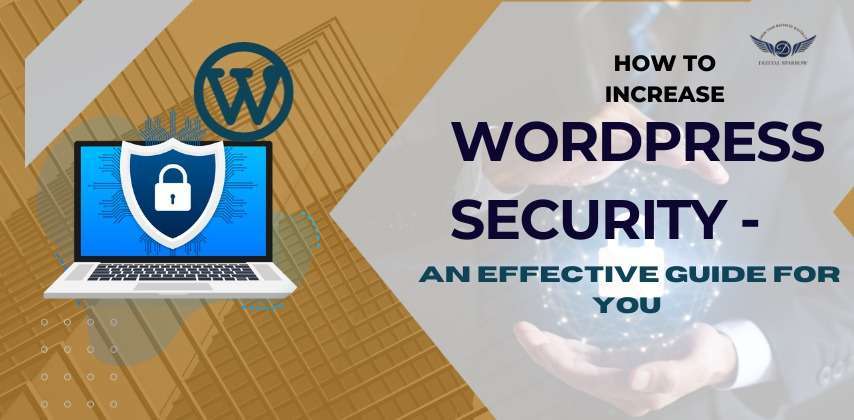WordPress is undoubtedly one of the most popular content management systems (CMS) globally, powering millions of websites. However, its widespread usage also makes it a prime target for hackers and malicious actors. Therefore, ensuring the security of your WordPress website is of paramount importance. In this guide, we’ll walk you through a comprehensive set of steps to enhance your WordPress security effectively.
1. Keep Everything Updated
Updating your WordPress website is critical for security. Update the WordPress core, themes, and plugins on a regular basis. Updates are released by developers to address vulnerabilities that hackers may exploit. Failure to update your site exposes it to potential attackers. Make checking for and applying updates a habit to guarantee your website is secure and performs properly. This simple practise will go a long way towards protecting your online presence from any threats.
2. Strong Passwords and 2FA
Enforcing strong passwords and adopting Two-Factor Authentication (2FA) are essential WordPress security features. Passwords should be unique and complicated, with a combination of uppercase and lowercase letters, numbers, and special characters. Encourage people to utilise password managers to save their passwords securely. 2FA adds an extra layer of security by forcing users to enter a one-time code generated by a secondary device, such as a smart phone app, after entering their password. This extra step increases security tremendously, making it difficult for unauthorised users to obtain access, even if they have the password. Strong passwords and 2FA work together to protect your WordPress site from unauthorised access and potential breaches.
3. Limit Login Attempts
Limiting login attempts is a vital security measure for your WordPress site. By implementing this safeguard, you restrict the number of times a user can attempt to log in within a specified time frame. This thwarts malicious actors attempting brute-force attacks, where they try multiple password combinations to gain unauthorized access. Utilize plug-ins like “Login Lock Down” or “Wordfence” to easily configure and enforce login attempt limits. This proactive approach significantly strengthens your website’s security by mitigating the risk of unauthorized access due to password guessing or hacking attempts.
4. Choose Secure Hosting
Choosing a secure hosting company is critical for protecting your WordPress site. A reliable hosting company provides powerful security features such as firewall protection, regular virus scans, and daily backups. These protections help to protect your website from a variety of threats and vulnerabilities. A secure hosting environment not only reduces the risk of assaults, but also ensures the availability and speed of your website. Investing in a reputable hosting provider is a critical first step in improving the overall security and stability of your WordPress site, allowing you to focus on your content and business without ongoing security concerns.
An SSL (Secure Sockets Layer) certificate is required for the security of your WordPress website. It encrypts data sent between your website and visitors, preventing bad actors from intercepting it. This encryption not only protects critical information but also improves the trustworthiness and search engine ranking of your website. An SSL certificate can be obtained easily from your hosting provider or from third-party certificate authority. It’s an important security layer that ensures customers that their data is secure, establishing trust and maintaining secure communication on your site, all of which are necessary for modern internet company and user confidence.
6. Disable Directory Listing
Disabling directory listing is a critical security measure for your WordPress site. By adding “Options -Indexes” to your site’s .htaccess file, you prevent unauthorized access to the contents of directories. Without this safeguard, hackers can potentially view and exploit sensitive files and data on your server. Disabling directory listing helps maintain the confidentiality of your website’s files and enhances security by ensuring that only authorized users can access specific resources, reducing the risk of data breaches and unauthorized access attempts.
7. Hide WordPress Version
Hide the WordPress version to improve your website’s security. Hackers can take advantage of known vulnerabilities in specific WordPress versions. You can lessen the chance of being targeted based on your software version by eliminating the WordPress version from your site’s Meta tags and scripts. This obfuscation makes it more difficult for malicious actors to uncover potential security flaws in your site. Hide the version number is a simple but effective way to protect your WordPress site from unwanted threats and attacks.
8. Change Database Prefix
It is critical to change the default database table prefix in WordPress from “wp_” to a unique and custom prefix. This practise makes it more difficult for hackers to guess table names and carry out SQL injection attacks. By changing this prefix during installation or via a plug-in, you give an extra layer of security to your site’s database, decreasing the possibility of unauthorised access and potential data breaches. It’s a simple but effective technique to improve the security of your WordPress site and protect your valuable data.
9. Regular Backups
Regular backups are a lifeline for your WordPress website’s security. They involve creating copies of your site’s databases and files at scheduled intervals, ensuring that you can restore your site to a previous, functional state in case of data loss, hacking, or other disasters. Reliable backup solutions, such as Up draft Plus or Backup Buddy, automate this process, saving backups to secure locations, either offline or in the cloud. Regular backups provide peace of mind, allowing you to recover quickly from unexpected events and minimize potential downtime, data loss, and damage to your online presence.
10. Security Plugins
Security plugins are crucial tools for improving the security of your WordPress site. “Wordfence” and “iThemes Security” are two examples of real-time monitoring, firewall capabilities, and malware detection. They actively detect and respond to security threats like as infiltration attempts and malicious code. Security plugins provide useful data and notifications, allowing you to protect your site more proactively. You can fortify your WordPress site’s defences, discover weaknesses, and respond quickly to possible threats by utilising these solutions, assuring the safety of your digital assets.
WordPress security relies heavily on file permissions. By properly securing your files and folders, you can ensure that only authorised users and programmes may access and alter them. In most circumstances, files should be set to 644 (readable by the owner and group, and readable by others), and directories should be set to 755 (executable by the owner and group, and accessible to others). The wp-config.php file, which contains critical database information, should have permissions set to 400, allowing only the owner access. File permissions that are set correctly reduce the risk of unauthorised access and manipulation with your site’s files.
12. Disable XML-RPC
Disabling XML-RPC is a prudent security measure for your WordPress site. XML-RPC is a remote communication protocol that, when left enabled, can be exploited for various malicious purposes, including DDoS attacks and brute force login attempts. By deactivating XML-RPC, you reduce the attack surface and improve your site’s security. This can be accomplished by adding code to your site’s.htaccess file or by using a security plugin. Disabling XML-RPC effectively helps mitigate potential risks and safeguard your website from unauthorised access and abuse.
13. Monitor User Activity
Monitoring user activity is vital for WordPress security. Regularly review and manage user accounts, especially administrative ones, to ensure they are necessary and legitimate. By maintaining an updated list of authorized users and their privileges, you reduce the risk of unauthorized access and potential security breaches. Stay vigilant for any suspicious or unusual user behavior, and promptly investigate and address any security concerns to maintain a secure online environment for your WordPress site.
14. Security Headers
The use of security headers is an important part of WordPress security. HTTP response headers that give an extra layer of security to your website are known as security headers. Content Security Policy (CSP), for example, limits the sources from which content can be loaded, lowering the danger of cross-site scripting attacks. Other headers, like as X-Content-Type-Options and X-Frame-Options, protect against specific sorts of attacks and content embedding. Configuring these headers correctly protects your site from different online dangers and improves its overall security posture.
15. Secure File Uploads
Ensuring secure file uploads is essential for WordPress security. Validate and restrict file types that users can upload to your site. Implement strong input validation and security checks to prevent malicious file uploads, which can lead to code execution or malware injection. By maintaining strict control over file uploads, you reduce the risk of compromising your website’s integrity and protect your users from potential security threats associated with malicious files.
16. Regular Security Audits
Regular security audits are an important component of WordPress security. Scan your website on a regular basis with tools like WPScan or online vulnerability scanners to uncover flaws, obsolete software, or suspicious activities. Addressing any vulnerability detected during these audits as soon as possible eliminates potential security breaches and keeps your site secure. It’s an important preventative move to ensure your WordPress site is robust to evolving threats and provides a safe environment for both you and your visitors, preserving trust and integrity.
17. Educate Yourself and Your Team
WordPress security is built on education. Update your and your team’s awareness of prevalent security dangers and best practices on a regular basis. Keep up to date on the newest security trends and vulnerabilities. Training and awareness guarantee that everyone engaged is aware of the risks and is prepared to respond to security problems. Updating your abilities on a regular basis and remaining watchful are critical to keeping a safe WordPress site. A well-informed workforce is better able to safeguard your website and user data from potential dangers.
A WordPress firewall is an important safeguard for your website. By screening incoming traffic, it acts as a barrier between your site and potential dangers. This security layer identifies and prevents bad requests, such as hacking attempts or malicious scripts, from reaching your WordPress installation. Implementing a WordPress firewall, whether via plugins or web application firewalls (WAFs), is critical for protecting your site from a variety of online dangers. It improves security dramatically by blocking assaults and delivering a safer online environment for your visitors and data.
How to boost 2024 Seo performance- https://startupadvice.in/how-to-boost-2024-seo-performance-with-pillar-pages-topic-clusters/
Conclusion
WordPress security is not a one-time task but an ongoing process. By following these steps and staying vigilant, you can significantly improve the security of your WordPress website and reduce the risk of data breaches and other security incidents. Your website’s security is in your hands – make sure to protect it effectively.
Remember, it’s always better to be proactive than reactive when it comes to security. Don’t wait for an attack to happen; start securing your WordPress site today. Your website’s integrity and your visitors’ trust are worth the effort.


I don’t think the title of your article matches the content lol. Just kidding, mainly because I had some doubts after reading the article.
BWER leads the way in weighbridge technology in Iraq, delivering customized weighing solutions that are accurate, efficient, and ideal for heavy-duty use in any environment.
Pentru servicii de contabilitate Chi?inau, Lorand Expert este liderul pe pia?a. Oferim solu?ii personalizate pentru afacerile locale, asigurand respectarea reglementarilor fiscale ?i optimizarea proceselor financiare.
С нами вы не останетесь без денег! 55 МФО предлагают мфо с плохой историей без отказа с круглосуточным одобрением. Быстро, надежно и без лишних хлопот.